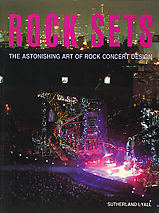Published by Thames and Hudson, 1992. Reviewed by Glenn Povey.
 Published
in the UK by Thames and Hudson, "Rock Sets" is the stunning visual
history of behind-the-scenes technical design wizards Mark Fisher and
Jonathan Park. They are, of course, the London-based team, Fisher-Park,
who's creative genius for rock shows has made it possible for us to
enjoy what could be a stupendously boring affair. Published
in the UK by Thames and Hudson, "Rock Sets" is the stunning visual
history of behind-the-scenes technical design wizards Mark Fisher and
Jonathan Park. They are, of course, the London-based team, Fisher-Park,
who's creative genius for rock shows has made it possible for us to
enjoy what could be a stupendously boring affair.
High on visual imagery, impact
and resourcefulness, Fisher-Park have carved a niche for themselves as
the leading concert designers for nearly every major act in the world.
Ranging from the huge scaffolding jumble sale scrap yard that the
Rolling Stones carted around the USA for "Steel Wheels", the almost
Roger Dean-esque scapes that formed Stevie Wonder's "Hotter Than July"
set, to the magnificent scale of Jean-Michel Jarre's show in Houston in
1986. Of course, the more studious among us will have read their Pink
Floyd programmes and the name Fisher-Park is almost synonymous with
"The Wall" show tour and Roger Waters solo tours of "Pros & Cons"
and "Radio KAOS" (not to mention the huge Wall In Berlin re-run).
Pink Floyd were the kick-start
for Fisher-Park's rock career back in 1977 when they were asked to
design a series of inflatables for their live shows. Both had careers
in design/architecture, and had been constructing inflatables and
lightweight structures as early as 1966. The pair didn't team up until
1976, but the call from Floyd later that year to work on the "Animals"
tour was a critical one in their career. You could almost say the rest
is history.
It is interesting to see that
stadium rock has advanced only in as far as the sets are concerned. The
emphasis is always on the visual impact. The ability to keep the fans
in the back entertained is a critical point in their business.
What I found oddly remarkable
about this book is its simplicity, yet fine attention to detail. Apart
from the glossy presentation, there are three large foldouts giving
panoramic views of stage designs and a plethora of previously
unpublished photos.
But what really sells this book
is the study of the whole design development from rough sketches
through the computer line drawings, and finally their transformation
into the finished product.
Furthermore, and a real treat for
Floydies, are the detailed notes on the 1977 tour, including the sheep
cannons, the 1980-81 Wall tour incorporating the "slug" concert hall,
and especially the 1975 tour pyramid design which was revived in 1977
for possible reuse on future tours.
The book is so full of little
treats like this it's hard to put down, and like I said, it is so
visually stunning in itself you can gawp at it for hours. The only down
point is a few mixed up dates appearing here and there, but this is
nit-picking really. If you're looking for an interesting departure from
the norm in music books, try it out. Although it can be read cover to
cover in one (extended) reading session, this is because you won't want
to put it down!
|
 Reviews
Reviews  Books
Books  "Rock Sets" - Sutherland Lyall
"Rock Sets" - Sutherland Lyall








 Published
in the UK by Thames and Hudson, "Rock Sets" is the stunning visual
history of behind-the-scenes technical design wizards Mark Fisher and
Jonathan Park. They are, of course, the London-based team, Fisher-Park,
who's creative genius for rock shows has made it possible for us to
enjoy what could be a stupendously boring affair.
Published
in the UK by Thames and Hudson, "Rock Sets" is the stunning visual
history of behind-the-scenes technical design wizards Mark Fisher and
Jonathan Park. They are, of course, the London-based team, Fisher-Park,
who's creative genius for rock shows has made it possible for us to
enjoy what could be a stupendously boring affair.



